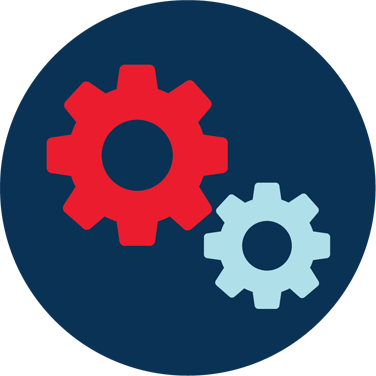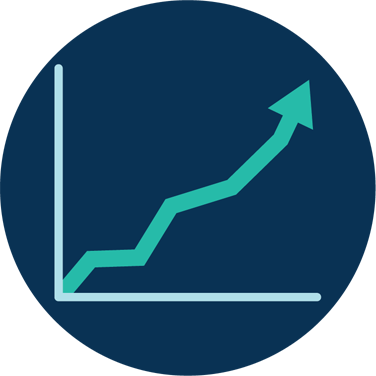Executive Summary
Today financial services firms are recognizing the need to shift from digital-only approaches back to a focus on human interaction. FinTechs especially have seen that real human guidance builds the all-important trust factor with customers, driving engagement and both frequent and smart product usage. Neighborhood Trust’s solution, linking our expert Financial Coaching to a technology platform so trusted guidance is packaged with vetted financial tools, positions us to be an invaluable feature of financial products, especially those products that aim to solve for short-term financial stability challenges facing most working families.
We are now launching TrustPlus as a human guidance feature of select, pioneer FinTechs. Together we will design solutions that help workers alleviate financial stress and achieve financial health, while proving the value of the human touch in FinTech products.
Today, we have a high-leverage market opportunity to help FinTechs solve their human touch deficit.
Financial services in the U.S. are in a time of flux, with renewed emphasis on the role of human interaction to drive customer trust.
Following over a decade of innovation in the financial services market, which saw the rise of FinTech and digital-first approaches to customer acquisition and servicing, the market trend today is a decided (re)focus on the importance of human interaction between businesses and their customers. For example, to create human-like digital experiences, we’ve seen the rise of personalization driven by AI—such as chatbots and robo-advisors.
But providers know that, at critical touchpoints in the digital customer experience, people need to talk to a real human to drive outcomes like product usage, engagement, and financial behavior change. These outcomes require trust between provider and customer, which a human agent can uniquely cement (see Box 2: Human v. Machine). Thus, FinTechs are increasingly integrating call center support at critical touchpoints, retail bank branches are being re-conceptualized to streamline digital and brick-and-mortar experiences, and digital-first investment services are integrating human financial advisors.[1]
The same pivot back to human interaction is happening in other sectors, such as behavioral health and chronic disease management, where solutions that combine digital + human interaction (often in phone sessions with a counselor or coach) are gaining popularity.[2] For example, research shows that wrapping a human coach relationship around a digital mental health solution delivers superior results than an app alone, in part because of the accountability and empathy a real human provides.[3]
Box 1: BACKGROUND: THE PROBLEM TrustPlus IS SOLVING
Today’s workers face growing short-term financial pressures and lack tools to manage. This affects their workplace productivity and prevents them from working toward long-term financial goals. Deregulation, globalization, and the use of technology in the workplace that began in the early 1990s have not kept the promise of distributing the productivity gains to all of the U.S. labor force. Instead, today’s workers have seen stagnating wages, declining benefits, and greater instability and income volatility as a result. The unpredictability of income makes managing short-term household cashflows increasingly complex. And having a job no longer guarantees that a worker can support a family.
The Total Addressable Market (TAM) that needs our solution is, unfortunately, gigantic: 35 million U.S. households are employed with above-poverty-line wages, but they are not earning a living wage. These workers cannot afford basic expenses such as housing, transportation, childcare, and utilities. And, as many as 60% of workers experience variable work schedules. This creates highly volatile income streams and requires careful cashflow planning they are ill-equipped to manage. Lacking the right guidance and financial tools, workers are prone to take on predatory debt, raid their 401(k) or other retirement savings, and put off strategies to build assets, all decisions which reinforce the cycle of financial insecurity.[1]
In fact, short-term financial challenges affect over half of working Americans, not only the income poor. While it is true low-income workers are disproportionately affected, over time most U.S. workers will need guidance on managing budget shortfalls, and they will need the right tools to manage cashflow, build an emergency fund, and avoid debt traps. Nearly half of U.S. workers are unable to cover an unforeseen $400 expense, and over half do not have any retirement savings. It is no wonder stress is high, with 85 percent of Americans anxious about money.[2] As a result, today 25 percent of employers are now offering some kind of workplace financial wellness program to their employees, knowing worker financial stress affects their bottom lines.
[1] 12 million Americans resort to expensive payday loans each year, more often than not to cover ordinary budget shortfalls. As many as one in every four people with a 401(k) or other defined contribution retirement plan will use all or some of these savings for nonretirement needs, in most cases to address basic money management challenges. [2]The Society for Human Resource Management reports that almost two out of five workers experienced more financial strain after the Great Recession ended than when it began, and the American Psychological Association finds that financial concerns are Americans’ Number 1 ranked source of stress.
Demand is growing for our human Financial Coaching.
Workplace FinTechs are looking for a partner who can deliver human guidance on short-term financial challenges as a feature of their products.
A growing number of FinTechs in the U.S. focus on solving workers’ short-term financial instability and reach workers through the employer channel, but these are digital-first solutions that lack human touch. They may entirely lack human customer support or don’t provide the comprehensive one-on-one financial guidance workers need in order to use their products effectively. They are searching for new approaches and features that will earn customer trust, drive engagement, and deliver stronger impact.[4]
Why TrustPlus?
Our scan of the marketplace shows Financial Coaching players exist, but they are challenged by either impact or scale. Our strength lies in our credible promise to deliver both.
Few coaching providers can deliver what we do: nationwide service informed by behavioral science and specializing in the unique short-term financial challenges of low-income workers. Other worker-focused FinTechs offer coaching—but are just learning to focus on workers’ short-term financial stability—or offer debt relief without a preventative focus, limiting their impact.
We have first-mover advantage. The complexity of short-term financial insecurity is not new to us—we’ve been solving it for over 20 years.
Direct Financial Coaching is our core businesses. Since 1997, Neighborhood Trust has helped low- and moderate- income workers navigate the problem of short-term financial instability so they are positioned to build long-term financial security (See Box 1 for more on the problem we’re trying to solve). Early on, we began with a “high touch” model: sitting down with workers for face-to-face coaching, combining a trusted human’s guidance on challenges—like cashflow management, avoiding and paying down predatory debt, and building savings—with links to vetted financial products and tools to make behavioral change actionable. Today, we achieve those same results with our tele-coaching TrustPlus service in the workplace (see Box 3).
We are technophiles, with our own in-house product development team and online platform, and have experience first-hand linking our human coaching with digital tools to drive behavior change.
TrustPlus features an onboarding tool and a digital platform where users can create a budget, see their credit report and FICO score, and schedule a session with their counselor. Our technology is built in-house by our own highly experienced product development team, with a focus on user experience, product integration, data collection and analytics, and integration into workplace processes. We leverage human centered design to ensure we are addressing real user problems and finding solutions that are inspired by their ideas, preferences, and behaviors.
Box 2: HUMAN V. MACHINE: THE ROLE EACH PLAYS
Today’s workers face growing short-term financial pressures and lack tools to manage. This affects their workplace productivity and prevents them from working toward long-term financial goals. Deregulation, globalization, and the use of technology in the workplace that began in the early 1990s have not kept the promise of distributing the productivity gains to all of the U.S. labor force. Instead, today’s workers have seen stagnating wages, declining benefits, and greater instability and income volatility as a result. The unpredictability of income makes managing short-term household cashflows increasingly complex. And having a job no longer guarantees that a worker can support a family.
Humans still out-perform computers on critical tasks, such as pattern matching and complex communication requiring empathy.* Despite advances in Artificial Intelligence to solve some pattern-matching challenges, such as chess and self-driving cars, more complex problems (like the short-term financial instability we help workers solve for) still require human intelligence. A robo-advisor can recommend retirement investment allocations based on customer survey responses, but short-term financial challenges and their solutions are far more complex. Moreover, computers are inferior at adaptive communication, unable to accomplish the empathic connection humans do, which research shows is essential to bring about change in people’s lives.*
But computers have a role to play in augmenting human intelligence, such as by processing large datasets and presenting menus of options based on that data. However, when it comes to delivering advice and motivating behavioral change, a human needs to make sense of the options and present them to a user, like a sports coach who parses analytics for players on the field. Our TrustPlus coaches use pattern matching and adaptive, empathic communication to surface relevant and emotionally sensitive financial information from our user, in a confidential and trustworthy conversation, and then offer advice in a manner that motivates action and behavioral change.
* Levy, Frank and Richard J. Murnane. The New Division of Labor (2004). See also Nicholas Carr, The Glass Cage (2014) on automation, and Helen Riess, The Empathy Effect (2018) on neuro-science and psychiatry research on empathic connection.
We’ve honed our approach to deliver impact in a workplace model.
TrustPlususers have reduced debt, improved their credit scores, and planned for the future more effectively.Workers who used our service see dramatic results (see Box 5). 38 percent of these workers began planning their financial futures, completing a first step in their financial action plan, which has been proven to be a critical step in achieving both short and long-term results. Moreover, nearly nine in ten workers said that by receiving this service, they believe their employer cares about their wellbeing, feel they have someone they trust to talk to about money, and feel more confident making decisions about money.
We built TrustPlus on three core principles:
- Workers need a trustworthy human, a counselor, to help them navigate the complexity. Now, the FinTech has high demand to bundle our human touch into their products, too.
- Workers need the right tools to act on their counselor’s advice. This is why our integrations with FinTech products not only respond to a market opportunity for us, but also deliver impact. 68% of TrustPlususers started using online banking or another digital tool to track their cashflow after talking to one of our counselors, and 56% increased their savings contributions.
- We turbocharge our impact by leveraging everyday workplace processes, like payroll and benefits. Using the principles of behavioral economics, we re-engineer processes so that the ecosystem in which employees interact supports financial behavior change.
We’re partnering with select FinTechs to deliver scale and impact.
Our strategy for scale relies on smart partnerships, and our business model is a win-win for employers, workers, and FinTechs.
Today, we have successful pilot partners across the landscape that hire us to serve their workplace customers. We continue to sell TrustPlus direct to employers ourselves, but increasingly work in partnership with workplace FinTechs where we provide a much-needed human complement to their digital financial service, offering Financial Coaching as a feature in the product.
Box 3: HOW DOES TrustPlus WORK?
Deo is a 25-year-old truck driver in Texas, earning $9.25 per hour and with medical and credit card debt totaling $17,000, including $7,215 in collections. His credit score is subprime at 460.
One day, he receives an SMS reminder from his HR department that, as an employee, he is eligible for free Financial Coaching from Neighborhood Trust. He clicks on the link and signs up.
The next day, he is on the phone with his TrustPlus counselor Sarah Wen. They come up with a plan to tackle his collections, eliminating some and negotiating the rest. They also rehabilitate his student loans, enrolling in an income-based plan with automatic payments. Sarah makes product recommendations to support his goals, including opening a savings account and signing up for split direct deposit; and a secure loan product to rebuild credit.
After the session, he receives texts from Sarah with a link to sign up for an online savings account and reminders to mail collections letters and to stick to his budget.
He stays in touch with Sarah, speaking with her two more times and texting five times over the next few months.
After six months, he is optimistic and in control of his financial future. He eliminated his medical and consumer debt and all collections. His student loans are up to date, his credit score shot up to 654, and he continues to improve his credit with safe loan products.
Our FinTech partnership strategy is to work with select, mission-aligned FinTechs that are 1) passionate about solving for financial insecurity among workers, 2) recognize the need for a human touch in financial technology solutions, and 3) are eager to tackle a good design challenge and learn together in an effort to scale our services and, as a nonprofit social enterprise, our impact. Guided by core principles we developed that outline our approach and value, we aim to help improve the financial outcomes of workers across the country through our services and by sharing our lessons learned with the industry.
We have launched pilots with several FinTechs (See Box 4) to test how:
- A product’s data insights can direct users to coaching. How can the product use its data to recommend users to our coaching, at the moment they experience a life change that may require coaching?
- Our coaching can be a catalyst for product take-up and usage. Are we the starting point, and a resource along the way, for engaging with products as part of a personalized financial plan?
Box 4: OUR PIONEER FINTECHS
We seek to prove out a service model for linking coaching with FinTech products. Users will improve their financial health through outcomes in improved savings and cash flow, and improved credit and debt profiles. Concurrently, we will prove the value of linking human-touch coaching with FinTech products.
Box 5: TrustPlus’ Impact on Workers
Conclusion
We believe human guidance is an important feature of financial products—and our tele-coaching service TrustPlus is designed to provide the human touch FinTech products seek to address the gap left by their digital-first platforms. Neighborhood Trust is currently partnering with select FinTechs to design solutions that will improve workers financial health—and prove the value of human guidance in FinTech products. If you are interested in partnering with us, complete this form: TrustPlus for FinTechs.
Appendix: A Sample of Our Fintech Toolkit
OUR GUIDING PRINCIPLES FOR FINTECH PARTNERSHIPS
We’re excited to partner to offer Financial Coaching as a feature in your product. We believe that a trusted human expert is an essential component of an impactful financial product. Our Guiding Principles share how we can best work together to create a powerful FinTech solution that helps users achieve financial health and serves as a model for inclusive FinTech.
A Seamless User Experience
- Our goal is to build a seamless user experience, with TrustPlus embedded in your product. We aim to connect your users to coaching at strategic touch points in their product journey, removing any cognitive barriers to finding a counselor and presenting the opportunity at just the right time.
- You know your product best, and we’ll look to your expertise on the placement of TrustPlus within your product. As we continue to collaborate, we’re eager to share our industry-leading knowledge and provide input and guidance regarding the placement of TrustPlus in the user journey.
- We will look to you to train our Financial Coaches on all aspects of your product, and the user experience you seek to create. The TrustPlus user experience will then be both specific to your product itself and the solution it’s focused on and include more comprehensive financial goals.
The Trust Factor
- Your product aligns with our worker financial empowerment mission and we’re excited for our services to strengthen your product effectiveness, consistent with this mission.
- As part of our integrated experience, it’s important that your users see TrustPlus as a safe space following their journey from your platform. Given this, all Financial Coaching sessions are kept private, and users can continue to work with their financial counselor as often and as long as they need.
- Our promise to your users is that we always put their best interests first and we will recommend product solutions based on their financial needs. We will never receive compensation contingent on these recommendations and may recommend other financial solutions.
- While we engage your users within your product at a particular moment in the user journey, TrustPlus is a lifetime service, loyal to your user regardless of their continued use of your product or their employment status.
A Consistent Customer Experience
- We look forward to supporting your sales efforts and promoting the value of TrustPlus as a distinguishing product feature. We believe co-branding will best showcase our partnership and capitalize on employers’ interest in an unbiased, holistic coaching service, which is best provided by a nonprofit like us.
- Our sales team will be available to guide your team on best practices when talking about TrustPlus to your employer customers. We will provide you with marketing materials you may need to assist in your sales process. We will also make sales representatives available to train or assist your sales team during pitches or demos.
- Your team will have access to a Relationship Manager who is available to aid in the creation of a marketing plan to promote services to employees, provide ongoing data, and assist with any employer customer needs that may arise.
- Employer customers will receive monthly data to help understand their employees’ financial challenges, track usage of our Financial Coaching service and report its impact on their employees’ financial wellness.
TrustPlus Branding
- Our strategy is to position TrustPlus as a feature of select FinTechs.
- We believe showcasing our partnership as a co-branded effort and ensuring employers understand that Financial Coaching is being delivered by a third-party nonprofit (Neighborhood Trust) is beneficial to both our brands, reinforcing trust and credibility.
- Neighborhood Trust will provide specific guidelines on TrustPlus logos, fonts, colors, and messages about the service.
- All references to TrustPlus must be reviewed and approved by Neighborhood Trust.
Learning Is Key
- Through our partnership, we aim to demonstrate that our trusted financial guidance service offered as a feature of a FinTech makes that product more successful. Our Financial Coaches will support your users in making the most productive use of your product. And by providing the option of a trusted counselor who can listen to their story and understand their circumstances beyond the data, we anticipate that you will experience more user engagement and loyalty. We look forward to working together to gather data around this hypothesis.
- Both teams will regularly share aggregated (not personally identifiable) user data to ensure we are iterating and improving on the user experience overtime. We expect to have an agile process and a quick feedback loop where we can change the user journey based on our findings.
[1] See Forrester: Connect Banking Prospects with Human to Help Drive Sales, October 12, 2018; and American Banker: Bank customers still value human touch, July 6, 2017.
[2] Weingard, David. Paying for One-on-One Diabetes Coaching is Worth It. ThinkAdvisor, July 17, 2018.
[3] For mental health apps, human touch is key component, MobiHealth News, September 16, 2016; Schueller SM, Tomasino KN, Mohr DC. Integrating Human Support into Behavioral Intervention Technologies: The Efficiency Model of Support. Wiley: Clinical Psychology: Science and Practice. 2016(24):27-45.
[4] See the Aspen Institute, Nonprofit Leaders in Financial Technology, Fulfilling the Promise of FinTech: The Case for a Nonprofit Vision and Leadership: the nLIFT Manifesto, September 11, 2018.














